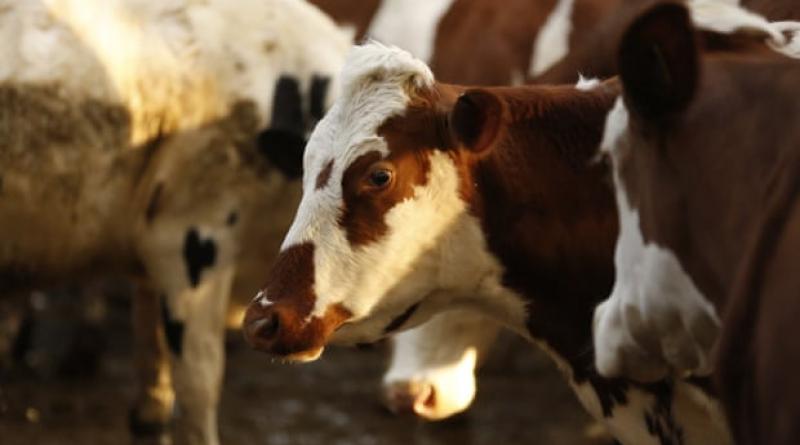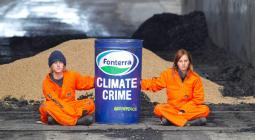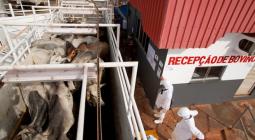Emissions from 13 dairy firms match those of entire UK, says report.

Exclusive: Milk giants’ climate impact rising and production caps needed, say researchers.
The biggest dairy companies in the world have the same combined greenhouse gas emissions as the UK, the sixth biggest economy in the world, according to a new report.
The analysis shows the impact of the 13 firms on the climate crisis is growing, with an 11% increase in emissions in the two years after the 2015 Paris climate change agreement, largely due to consolidation in the sector. Scientific reports have shown that consumption of dairy, as well as meat, must be reduced significantly in rich nations to tackle the climate emergency.
The report, by the Institute for Agriculture and Trade Policy (IATP) in the US, also says the growth of giant dairy companies has helped force milk prices below the cost of production for the last decade, causing a crisis in rural livelihoods and requiring taxpayer subsidies to keep farmers afloat. The researchers say caps on production should be reintroduced to protect both the climate and small farmers.
“Unlike growing public scrutiny on fossil fuel companies, little public pressure exists to hold global meat and dairy corporations accountable for their emissions,” said Shefali Sharma, European director at IATP and report author. “Few of these companies are even reporting their emissions.”
“As governments ratchet up their climate goals, the rise of large-scale dairy and public incentives that further increase corporate dairy power, production and emissions must be stopped,” she said. “Rural livelihoods and our planet’s future depend on it.”
Dairy industry representatives said the report did not reflect the reality of the dairy sector. In a joint statement, Judith Bryans, president of the International Dairy Federation, and Donald Moore, executive director of the Global Dairy Platform, said: “The dairy sector is committed to producing nutritious foods in environmentally sound and responsible ways.”
“It’s very easy to put out a report that criticises and tries to paint a simple picture of a sector which doesn’t contain all of the nuances or realities of how the global dairy sector nourishes the world with nutrient-rich, safe foods and does so in a manner that strives for continued environmental improvements while providing livelihoods to a large percentage of the world’s population,” said Bryans and Moore.
A 2019 joint report by the UN Food and Agriculture Organization (FAO) and Global Dairy Platform said: “In order to limit temperature rise, the dairy sector must reduce its greenhouse gas emissions and work towards a low-carbon future … There is a clear case for immediate and more ambitious action.”
It said: “The [dairy] sector’s emissions have increased by 18% between 2005 and 2015 because overall milk production has grown substantially by 30%. The good news is that there are many opportunities within the sector to limit climate change by reducing emissions. While there is some uncertainty about the size and timing of changes, it is certain that it is happening.” The report did not consider reducing production.
Bryans and Moore said: “[Dairy’s] rich nutrition helps populations, particularly in developing nations, avoid malnutrition and poor health outcomes.” The biggest global producers of milk are the European Union, India and the US.
The IATP report used the UN FAO’s global livestock environmental assessment model to assign emission levels to dairy produced in different regions. These were then applied to the companies’ production quantities as calculated by the IFCN dairy research network.
More than 90% of the corporate dairy industries’ emissions are produced by the cows themselves, mostly in the form of methane. Research shows all plant-based milks, such as soya and oat, result in far fewer emissions than dairy milk.
The IATP report found emissions from the big companies rose from 306m tonnes of CO2-equivalent in 2015 to 338m tonnes in 2017. The UK’s annual emissions are 350m tonnes a year.
Consolidation in the dairy industry saw four out of five dairy farms close in the EU from 1981-2013, and 93% of family farms in dairy closing in the US since the 1970s. “You have to get bigger or get out,” said Sharma. “The key argument is this industry drives overproduction and low prices, which creates demand, and it has marketing power, which creates demand. Demand doesn’t just happen by accident.”
“There is growing support for supply management, a crucial policy that could address dairy’s twin crises. It prevents overproduction, balances supply and demand and stabilises prices,” she said.
15 June 2020
The Guardian




